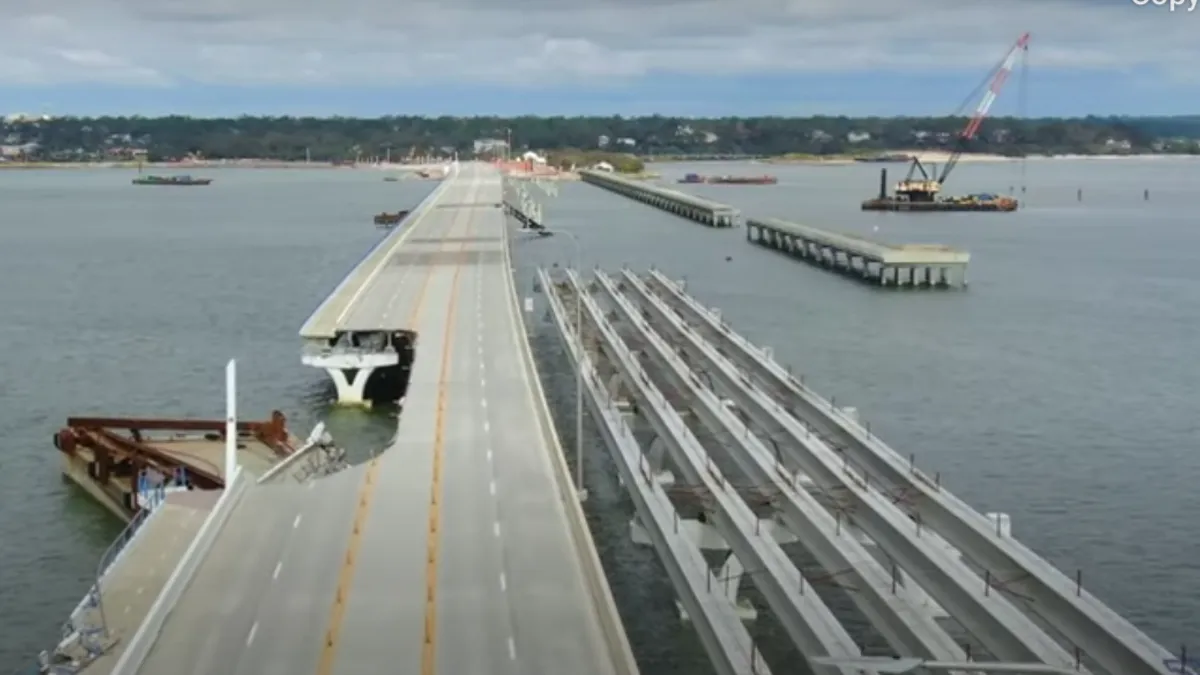UPDATE: June 3, 2021: The Florida DOT re-opened the damaged Pensacola Bay Bridge to traffic late last week.
The bridge is operating with two lanes of traffic in each direction, except for a two-lane, half-mile segment west of the bridge's arch while final repair work continues, FDOT said. The bridge was damaged by barges that broke loose from the $430 million construction project during Hurricane Sally in August.
FDOT noted that it is still withholding $35,000 per day from Skanska USA Civil Southeast, until traffic is fully restored. The expected completion date for all improvements is scheduled for January 2022.
UPDATE: Feb. 22, 2021: The Florida DOT has announced the phased re-opening of the Pensacola Bay Bridge in Pensacola, Florida, beginning next month.
During a Feb. 18 press conference, Florida DOT Secretary Kevin J. Thibault said the target date for opening one lane in each direction for the first 4,000 feet of the span on the Pensacola side is the week of March 22. During this first phase of reopening, two lanes in each direction will be open along the remaining 2 miles of the bridge. The FDOT expects the bridge to fully reopen by May 31.
FDOT is withholding $35,000 per day from Skanska USA Civil Southeast's payments until all four lanes of the bridge are open. Thiebault said Skanska would not get the money back once complete.
Dive Brief:
- Skanska USA Civil Southeast has turned to the federal courts in an attempt to eliminate or significantly reduce its liability for damages caused by barges that broke loose from the $430 million Pensacola Bay Bridge construction project during Hurricane Sally in August by having its barges recognized as vessels protected under maritime law.
- In five separate filings each covering a different barge, Skanska asked the U.S. District Court in Pensacola, Florida, to declare that it is not liable "for any loss, injuries or damages" related to barge damage, including economic losses suffered by businesses from the closure of the new span of the bridge. Skanska was working on the second span when 27 of its 55 barges escaped their moorings during the storm.
- The contractor's alternate request is that its liability be limited to the dollar amount of its ownership in each vessel, which Skanska has valued from $125,000 to $550,000 per barge. They want those funds, which total approximately $1.43 million, to be divided pro rata between all those submitting valid claims within a certain time period to be determined by the court. With each filing, Skanska has included a copy of a security bond equal to the value of each barge.
Dive Insight:
When asked about the lawsuits, a Skanska spokesperson told Construction Dive that the company does not comment on active or pending litigation.
Many local businesses claim that the closure of the Pensacola Bay Bridge and the subsequent diversion of traffic to the nearby Garcon Point Bridge has reduced traffic to their business, and, thus far, approximately 70 of them have filed suit in Escambia County Court seeking compensation for those losses. The state, according to its most recent update, has suspended tolls over the bridge until Jan. 12.
In October, the FDOT sent a letter to Skanska informing the company that it intended to seek reimbursement for lost toll revenue if the bridge's bondholders, which are owed at least $135 million, seek to recoup lost toll revenue form the state. Earlier this month, however, a state judge ruled that the bondholders cannot force the FDOT to make them whole as far as the tolls are concerned.
Since Hurricane Sally, Skanska has been working to repair the damage that the barges did to the Pensacola Bay Bridge, and the Florida DOT estimates that the bridge will reopen in March 2021. In a Dec. 10 update, the department reported that it has completed damage inspections and that contractors working on the bridge are pile driving and setting beams for reconstruction of the bridge. Pile driving work is taking place seven days a week.
The barges also damaged a nearby fishing pier, which Escambia County said will likely cost more than $28 million to demolish and rebuild.













